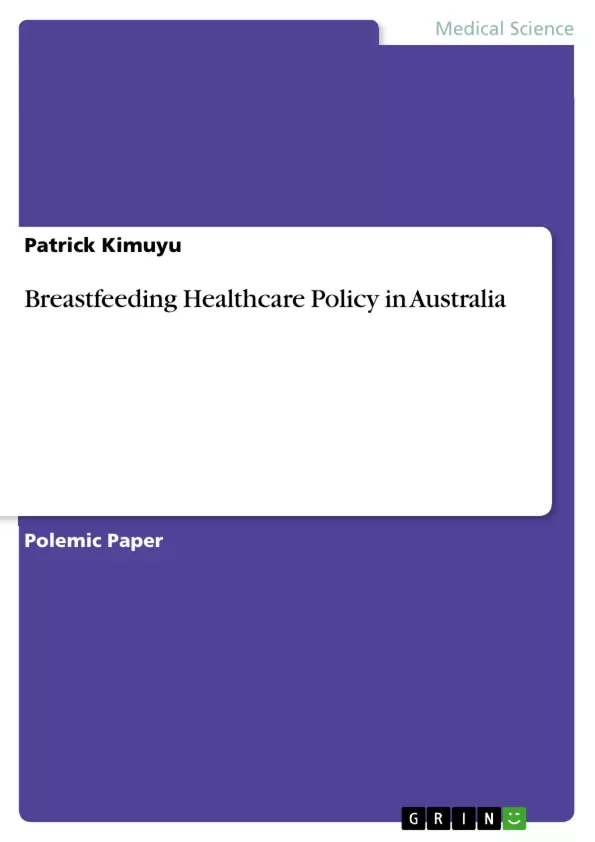In retrospect, nutrition has been a public health concern. As such, breastfeeding, a physical process, is considered as an essential element of infants’, as well as mothers’ wellbeing. Childhood nutrition underpins successful human development throughout the lifespan. In this context, breast milk, the primary infant’s source of nutrients plays essential roles in the child’s growth (Cadwell & Turner-Maffei, 2013). This explains the reason why the current healthcare policy reforms have shifted from focusing on adult nutrition to childhood nutrition. Over the decades, new evidence has been emerging regarding the benefits of breastfeeding. Overall, evidence indicates that breastfeeding plays significant roles in growth, development and survival of a child. It also promotes the wellbeing of the mother. This implies that breastfeeding exhibits a dual-benefit. Based on systematic literature reviews, breastfeeding has long-term benefits; it goes a long way in sustaining growth, development, defense against diseases, and wellbeing of an individual (Horta & Victora, 2013). On the one side, breastfeeding a child exclusively for six months has been found to influence the health of the child. It lowers the incidence of some childhood conditions such as obesity, childhood leukemia, diabetes mellitus, and inflammatory bowel disease. Similarly, exclusive breastfeeding reduces infant mortalities caused by otitis media, respiratory tract infections and diarrhea (Buontempo, Busuttil & Gauci, 2015). Additionally, breastfeeding has been found to have profound effects on mental development and chronic illnesses in later life. On the other side, breastfeeding has been found to have immediate, short-term, as well as long-term maternal benefits to mothers. Immediate effects are attributable to the stimulation of oxytocin which reduces the risk of postpartum hemorrhage. It also enhances the mother’s psychological health through reducing postpartum depression (Hamdan & Tamim, 2012). In this context, this paper focuses on providing a comprehensive analysis on breastfeeding healthcare policy through discussing the policymakers concern over the issue, competing policy options and organizational influence.
Inhaltsverzeichnis (Table of Contents)
- Introduction
- Policymakers' Breastfeeding Policy Concern
- Background Information
- Policy Analysis
- Policy Options
- Support Organization
Zielsetzung und Themenschwerpunkte (Objectives and Key Themes)
This paper provides a comprehensive analysis of breastfeeding healthcare policy in the US. It explores the policymakers' concerns regarding breastfeeding rates, examines the competing policy options available, and investigates the influence of support organizations. The paper also discusses the historical context of breastfeeding policy and the rationale behind current policy initiatives.
- Benefits of breastfeeding for both infants and mothers
- Barriers to breastfeeding in the US
- Competing policy options to promote breastfeeding
- Influence of support organizations on breastfeeding policy
- Impact of breastfeeding policy on workplace environments
Zusammenfassung der Kapitel (Chapter Summaries)
- Introduction: This chapter introduces the topic of breastfeeding and its significance as a public health concern. It highlights the benefits of breastfeeding for both infants and mothers, emphasizing the long-term health implications.
- Policymakers' Breastfeeding Policy Concern: This chapter examines the reasons why policymakers are concerned about breastfeeding rates in the US. It discusses factors such as cultural barriers, lack of supportive environments, and the health consequences of inadequate breastfeeding.
- Background Information: This chapter provides a historical overview of global policies and declarations on breastfeeding. It traces the evolution of breastfeeding policy, from the initial introduction of breastmilk substitutes to the development of international codes and guidelines.
- Policy Analysis: This chapter analyzes the current state of breastfeeding policy in the US, highlighting the barriers and competing policy options. It explores the rationale behind different policy approaches and examines the influence of support organizations.
- Policy Options: This section delves into two main policy options for promoting breastfeeding: break time provisions and infant and mother-friendly workplace provisions. It examines the benefits and drawbacks of each option and discusses the potential impact on employers and employees.
- Support Organization: This section focuses on the role of the American Public Health Association (APHA) in advocating for breastfeeding policy. It highlights APHA's position on the infant and mother-friendly workplace policy option and its support for programs and legislations that promote breastfeeding.
Schlüsselwörter (Keywords)
Breastfeeding, healthcare policy, infant health, maternal health, policy options, workplace environments, support organizations, cultural barriers, public health, break time provisions, infant and mother-friendly workplace provisions, American Public Health Association (APHA).
- Quote paper
- Patrick Kimuyu (Author), 2017, Breastfeeding Healthcare Policy in Australia, Munich, GRIN Verlag, https://www.grin.com/document/381302



